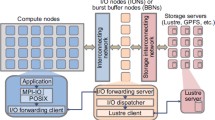Abstract
Clusters represent a collection of interconnected computers that collaborate on executing an application and present themselves as one unified computing resource. They are becoming an important segment in the computer industry. The two main flavors of cluster architectures are shared‐storage and shared‐nothing. This article presents host and I/O implementation details, and performance trade‐offs that need to be enforced due to sharing data in shared‐storage clusters. Sharing data requires the need for global concurrency and coherency protocols to maintain consistency of the database, and enforce data consistency in the local node’s buffers, respectively. Various shared‐storage architectures will be investigated, including the Virtual Shared and Shared‐Intermediate Memory models. This article also presents few selected shared‐storage clusters, including the DEC VAXCluster, IBM parallel Sysplex and Compaq/Tandem ServerNet.
Similar content being viewed by others
References
T. Agerwala, J.L. Martin, J.H. Mirza, D.C. Sadler, D.M. Dias and M. Snir, SP2 system architecture, IBM Systems Journal 34(2) (1995).
C.R. Attanasio, M. Butrico, C.A. Polyzois, S.E. Smith and J.L. Peterson, Design and implementation of a recoverable virtual shared disk, Research Report RC 19843, IBM T.J. Watson Research Center, Yorktown Heights, NY (1994).
C.K. Baru, G. Fecteau, A. Goyal, H. Hsiao, A. Jhingran, S. Padmanabhan, G.P. Copeland and W.G. Wilson, An overview of DB2 parallel edition, SIGMOD 24(2) (1995).
C.K. Baru, G. Fecteau, A. Goyal, H. Hsiao, A. Jhingran, S. Padmanabhan, G.P. Copeland and W.G. Wilson, DB2 parallel edition, IBM System Journal 34(2) (1995).
M.J. Carey, M.J. Franklin, M. Livny and E.J. Shekita, Data caching tradeoffs in client-server DBMS architecture, in: Proceedings of ACM SIGMOD (1991) pp. 357-366.
P.M. Chen, E.K. Lee, G.A. Gibson, R.H. Katz and D.A. Patterson, RAID: High-performance, reliable secondary storage, ACM Computing Surveys (June 1994).
P.M. Chen and Patterson, Maximizing performance in a striped-disk array, in: International Symposium on Computer Architecture (May 1990).
Compaq Corporation, Smart array 4200 controller, http://www.compaq.com/products/storageworks/.
D.W. Cornell, D.M. Dias and P.S. Yu, On multi-system coupling through function requests shipping, IEEE Transactions on Software Engineering 12(10) (October 1986).
A. Dan, D.M. Dias and P.S. Yu, Database buffer model for the data sharing environment, in: Proceedings of the 6th International Conference on Data Engineering (February 1990) pp. 538-544.
A. Dan and P.S. Yu, Performance analysis of coherency control policies through lock retention, in: Proceedings of ACM SIGMOD (June 1992) pp. 114-123.
A. Dan and P.S. Yu, Performance analysis of buffer coherency policies in a multi-system data sharing environment, IEEE Transactions on Parallel and Distributed Systems 4(3) (March 1993).
D.J. DeWitt, S. Ghandeharizadeh, D.A. Schneider, A. Bricker, H.-I. Hsiao and R. Rasmussen, The gamma database machine project, IEEE Transactions on Knowledge and Data Engineering 2(1) (March 1990).
D.M. Dias, B.R. Iyer, J.T. Robinson and P.S. Yu, Integrated concurrency-coherency for multi-system data sharing, IEEE Transactions on Software Engineering 15(4) (April 1989).
R.W. Horst and D. Garcia, ServerNet SAN I/O architecture, Hot Interconnect (1997).
Informix Corporation, XPS database, http://www.informix.com/.
International Business Machine DB2 database management product family, http://www-4.ibm.com/software/data/db2/.
International Business Machine serial storage architecture, http://www.storage.ibm.com/.
R.W. Kembel, The FibreChannel Consultant: A Comprehensive Introduction, Northwest Learning Associates, Inc. (1998).
G.M. King, D.M. Dias and P.S. Yu, Cluster architecture and S/390 Parallel Sysplex scalability, IBM System Journal 36(2) (1997).
N.P. Kronenberg, H.M. Levy and W.D. Strecker, VAXClusters: A closely coupled distributed system, ACM Transactions on Computer Systems 4(3) (May 1986) 130-146.
B. Lampson and H. Sturgis, Crash recovery in a distributed data storage system, Technical Report, Xerox PARC (1976).
P. Massiglia, The RAID Book — A Storage System Technology Handbook (Prentice-Hall, Englewood Cliffs, NJ, 1998).
J. Menon and J. Cortney, The architecture of a fault-tolerant cached RAID controller, in: Proceedings of the International Symposium on Computer Architecture (1993) pp. 76-86.
C. Mohan and B.G. Lindsay, Efficient commit protocols for the tree of processes model of distributed transactions, in: Proceedings of 2nd ACM SIGACT-SIGOPS Symposium on Distributed Computing (1983).
J.M. Nick, B.B. Moore, J.-Y. Chung and N.S. Bowen, S/390 cluster technology: Parallel Sysplex, IBM System Journal 36(2) (1997).
Oracle Parallel Server, http://www.oracle.com/.
R.H. Patterson, G.A. Gibson, E. Ginting, D. Stodolsky and J. Zelenka, Informed prefetching and caching, in: Proceedings of the 15th Symposium on Operating Systems Principles (1995) pp. 79-95.
D.A. Patterson, G.A. Gibson and R.H. Katz, A case for redundant arrays of inexpensive disks (RAID), in: Proceedings of the 1988 ACM SIGMOD Conference on Management of Data (June 1988) pp. 109-116.
G.F. Pfister, In Search of Clusters (Prentice-Hall, Englewood Cliffs, NJ, 1995).
E. Rahm, Design of Optimistic Methods for Concurrency Control in Database Sharing Systems, in: Proceedings of the International Conference on Distributed Computing Systems (1987).
R. Ramakrishnan and J. Gehrke, Database Management Systems (McGraw-Hill, 2000).
P. Stenstrom, A survey of cache coherence schemes for multiprocessors, IEEE Computer 23(6) (June 1990).
M. Stonebraker, The case of shared-nothing, IEEE Database Engineering 9(1) (1986).
The Tandem Database Group, NonStop SQL: A distributed high-performance, high-availability implementation of SQL, in: Proceedings of the Second International Workshop on High-performance Transaction Systems (September 1987).
J. Wilkes, R. Goldberg, C. Staelin and T. Sullivan, The HP AutoRAID hierarchical storage system, ACM Transactions on Computer Systems 14(1) (February 1996) 108-136.
P.S. Yu, D. Cornell, D.M. Dias and A. Thomasian, Performance comparison of I/O shipping and database call shipping: Schemes in multi-system partitioned databases, Performance Evaluation 10 (1989).
P.S. Yu and A Dan, Performance analysis of affinity clustering on transaction processing coupling architecture, IEEE Transactions on Knowledge and Data Engineering 6(5) (October 1994).
P.S. Yu, D.M. Dias, J.T. Robinson, B.R. Iyer and D.W. Cornell, On coupling multi-systems through data sharing, Proceedings of the IEEE 75(5) (May 1987).
Author information
Authors and Affiliations
Rights and permissions
About this article
Cite this article
Yousif, M. Shared‐storage clusters. Cluster Computing 2, 249–257 (1999). https://doi.org/10.1023/A:1019095112733
Issue Date:
DOI: https://doi.org/10.1023/A:1019095112733




